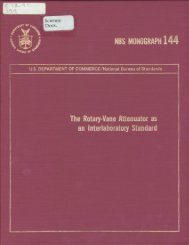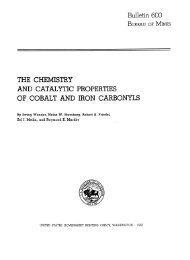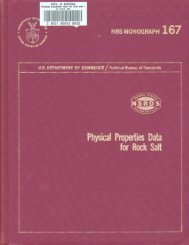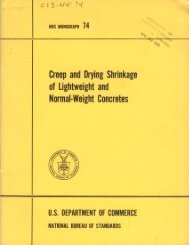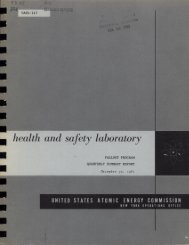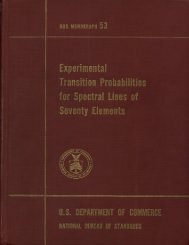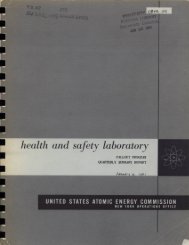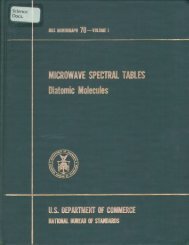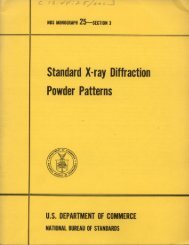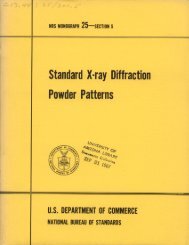Corrosion of Steel Pilings in Soils
Corrosion of Steel Pilings in Soils
Corrosion of Steel Pilings in Soils
- No tags were found...
You also want an ePaper? Increase the reach of your titles
YUMPU automatically turns print PDFs into web optimized ePapers that Google loves.
exposure, 0.005 <strong>in</strong>./yr for wett<strong>in</strong>g and dry<strong>in</strong>g exposure, and 0.001 <strong>in</strong>./yr for subsand exposure. Itwas estimated that the time required for the perforation <strong>of</strong> %-<strong>in</strong>. steel would be, respectively, 34 yr, 75yr, and 375 yr. In the abrasion zone, the steel lostan average thickness <strong>of</strong> 0.117 <strong>in</strong>./yr.Rayner and Ross [13] issued a comprehensive report on the durability <strong>of</strong> sheet steel pil<strong>in</strong>gs <strong>in</strong> 94structures which have been <strong>in</strong> service for variousperiods up to about 25 yr along the Atlantic Coastand the Gulf Coast <strong>of</strong> Florida. Comparison <strong>of</strong> rates<strong>of</strong> loss <strong>of</strong> thickness for steel piles used <strong>in</strong> the bulkheads<strong>in</strong>dicates that lack <strong>of</strong> backfill for all or part <strong>of</strong> thetime greatly <strong>in</strong>creased the rate <strong>of</strong> loss. For beachbulkheads the rate <strong>of</strong> loss rapidly decreased as thesand cover <strong>in</strong>creased. For gro<strong>in</strong>s and jetties therates <strong>of</strong> loss were uniformly high except for thosecovered on both sides. It was concluded that sandor earth cover materially decreased the loss <strong>of</strong> thickness <strong>of</strong> steel piles used <strong>in</strong> shore structures, the rates<strong>of</strong> loss for all practical purposes be<strong>in</strong>g negligible forpil<strong>in</strong>gs covered on both sides. Four groups <strong>of</strong> pileswere pulled from moderately polluted sea water locations dur<strong>in</strong>g the period <strong>of</strong> <strong>in</strong>vestigation, three <strong>of</strong>the groups located at Miami, Fla., which have been<strong>in</strong> service for 10 yr, and one group which had been<strong>in</strong> service for 18 yr at Stamford, Conn. Approximately 10 ft <strong>of</strong> the piles were driven below the groundl<strong>in</strong>e. The average annual rates <strong>of</strong> loss <strong>of</strong> thickness<strong>of</strong> the piles varied between 0.0009 and 0.0022 <strong>in</strong>. atthe four sites. The maximum rate, which generallyoccurred with<strong>in</strong> the zone 2 to 3 ft below the groundl<strong>in</strong>e, was 0.003 <strong>in</strong>./yr.Bjerrum [14] made measurements on steel pileswhich were pulled from three locations <strong>in</strong> Norway.Observations on a 17-ft length <strong>of</strong> pile which wasdriven 17 yr prior to <strong>in</strong>spection <strong>in</strong> a silty clay hav<strong>in</strong>ga resistivity between 2,000 and 4,000 ohm-cm showedan attack less than 0.003 <strong>in</strong>. Another 17-ft pile waspulled after exposure for 18 yr <strong>in</strong> a clay soil <strong>of</strong> mar<strong>in</strong>eorig<strong>in</strong>. In spite <strong>of</strong> the low resistivity <strong>of</strong> this soil,50 ohm-cm, the corrosion varied from 0.01 to 0.02 <strong>in</strong>.The third pile, exposed to a low resistivity mar<strong>in</strong>eclay for 6.5 yr, showed maximum corrosion <strong>of</strong> 0.10<strong>in</strong>. which corresponds to an average rate <strong>of</strong> morethan 0.01 <strong>in</strong>./yr <strong>in</strong> a 6-ft zone located between 11and 17 ft below the ground l<strong>in</strong>e. <strong>Corrosion</strong> above orbelow this zone on the rema<strong>in</strong><strong>in</strong>g pile areas did notexceed 0.02 <strong>in</strong>., or a rate <strong>of</strong> 0.003 <strong>in</strong>./yr. No mentionis made <strong>of</strong> the water l<strong>in</strong>e elevation at any <strong>of</strong> thelocations where the Norwegian piles were pulled.The writer, <strong>in</strong> view <strong>of</strong> his experiences <strong>in</strong> the exam<strong>in</strong>ation <strong>of</strong> steel piles, suggests the possibility that theaccelerated attack, reported by Bjerrum on the thirdpile, may have occurred <strong>in</strong> a water table zone.3. Inspection Procedure3.1. Piles Extracted From Location<strong>Steel</strong> H-piles were pulled from two locations andsteel sheet piles were pulled from six locations. Thewriter participated <strong>in</strong> all <strong>in</strong>spections on the pil<strong>in</strong>gswith the exception <strong>of</strong> the H-pile extracted from theBonnet Carre Spillway. The data perta<strong>in</strong><strong>in</strong>g to thelatter <strong>in</strong>spection were obta<strong>in</strong>ed from the files <strong>of</strong> theCorps <strong>of</strong> Eng<strong>in</strong>eers, U.S. Army Division, LowerMississippi Valley.After the soil and corrosion products were cleanedfrom the pile surface by utiliz<strong>in</strong>g wire brushes andscrapers, the extent <strong>of</strong> corrosion was determ<strong>in</strong>ed byvisual observation, pit depth measurements madewith micrometers, and thickness measurements madewith calipers.Pile sections pulled from the Ouachita River Damand Lock No. 8, the Grenada Dam Spillway, the SardisDam Spillway, and the Lumber River C<strong>of</strong>ferdamstructure were shipped to the National Bureau <strong>of</strong>Standards. These were cleaned by sandblast<strong>in</strong>g topermit a more comprehensive exam<strong>in</strong>ation <strong>of</strong> thepile surfaces <strong>in</strong> the laboratory.The results <strong>of</strong> all the <strong>in</strong>spections <strong>of</strong> the extractedpiles are given <strong>in</strong> section 4.1.3.2. Piles Inspected <strong>in</strong> Excavated Test HolesAt locations where it was not possible to pull thepiles without disturbance to the exist<strong>in</strong>g structure,test holes were excavated adjacent to the sheet steelpil<strong>in</strong>gs to expose a width <strong>of</strong> pil<strong>in</strong>g at each location.At the start <strong>of</strong> the <strong>in</strong>vestigation it was planned toexpose the pil<strong>in</strong>gs to a maximum depth <strong>of</strong> 15 ftfrom the surface, but at most locations the watertable did not permit excavat<strong>in</strong>g to this depth.Two excavations were made at each <strong>of</strong> four Corps<strong>of</strong> Eng<strong>in</strong>eers structures and one excavation at each<strong>of</strong> three Corps <strong>of</strong> Eng<strong>in</strong>eers structures to exam<strong>in</strong>esheet steel pil<strong>in</strong>gs which have been <strong>in</strong> service <strong>in</strong> avariety <strong>of</strong> soil environments.The soil and corrosion products were removedfrom the exposed pil<strong>in</strong>g by wire brush<strong>in</strong>g andscrap<strong>in</strong>g. The condition from the top <strong>of</strong> the pilesto the depth <strong>of</strong> excavation was determ<strong>in</strong>ed by visualobservation and pit depths were measured.A portion <strong>of</strong> the pile web, approximately 1 ft by2 ft, was cut from the area that showed the maximumamount <strong>of</strong> corrosion at each location. The removed,portions were shipped to the Vicksburg DistrictFoundation and Materials Branch Laboratory <strong>of</strong>the Corps <strong>of</strong> Eng<strong>in</strong>eers, and then to the NationalBureau <strong>of</strong> Standards for further exam<strong>in</strong>ation.The results <strong>of</strong> exam<strong>in</strong>ations made on the piles <strong>in</strong>the excavated test holes are given <strong>in</strong> section 4.2.3.3. Soil Characteristics and PropertiesDeterm<strong>in</strong>ations <strong>of</strong> the soil types for the differenthorizons at the locations where piles were pulledwere made from soil samples adher<strong>in</strong>g to the walls<strong>of</strong> the pil<strong>in</strong>gs. To serve as an additional check on thesoil types, eng<strong>in</strong>eers <strong>in</strong> charge <strong>of</strong> the structures provided soil bor<strong>in</strong>g data for the excavations at BonnetCarre Spillway, Grenada Dam Spillway, Wilm<strong>in</strong>gtonMar<strong>in</strong>e Term<strong>in</strong>al, and Sparrows Po<strong>in</strong>t. Soil samples removed from the pile surfaces were shipped tothe National Bureau <strong>of</strong> Standards laboratory formeasurements <strong>of</strong> soil resistivity and pH.\ at somelocations, where shown <strong>in</strong> section 4, soil resistivity



